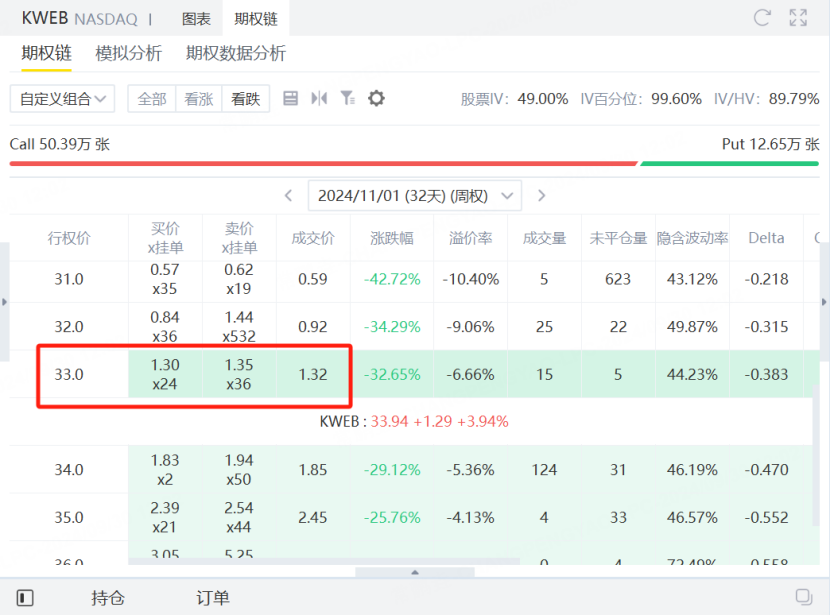Bull Put Spread for High Chinese Assets
Last week, China announced an unexpectedly large stimulus package, driving Hong Kong stocks to their biggest weekly gain in nearly 13 years. This puts them in a strong position to become one of the best-performing markets globally in 2024.
Meanwhile, the Shanghai Composite Index skyrocketed from 2,700 to the long-elusive 3,000-point mark.
HSI 11-day rally
What’s really interesting is that market participants, especially foreign institutions, are aggressively chasing gains through call options. This has pushed the volatility hedging costs for Hong Kong stocks next month to a two-year high, showing that investors have increasing confidence in the mid-term.
Unfortunately, this also means that those betting against Chinese stocks and seeking “neutral hedging” strategies have taken a serious hit, with some institutions even facing blow up. If investors short the Chinese market or use neutral hedging strategies (like buying puts while holding long positions), they could face hefty losses due to the market’s explosive short-term rise.
In just a few days, the Chinese government rolled out a series of impressive stimulus measures covering everything from consumer spending to the real estate and stock markets. The benchmark Hong Kong index $HSI(HSI)$ barely managed a 22% gain for the year, marking an impressive 11-day rally, the longest since the glory days of 2018.
For investors looking to seize this opportunity while managing risk, a bull put spread strategy could be the way to go.
Bull Put Spread Strategy
The bull put spread involves selling a put option while simultaneously buying another put option with the same expiration date but a lower strike price on the same underlying asset. Since the premium received from selling the put option is higher than the premium paid for buying the lower strike put, investors typically end up with a net premium.
This strategy is great when investors expect prices to rise but want to limit their downside risk in case of a market drop. If the market does fall, selling puts can be risky, but a bull put spread can help you profit in a volatile market by capping those risks.
1.Bull Put Spread Example with KWEB
Let’s take KWEB as an example. On September 30, before U.S. market opening, KWEB’s after-hours trading price was $35.60. An options trader expects the price to hit $45 in a month but is worried about potential downside risks.
Step 1: Sell a put option contract expiration date of November 1 with a strike price of $45, for a premium of $10 and bringing in $1,000.


2.Maximum Profit and Loss
- Maximum Profit:It occurs if KWEB's price is above $45. In this case, neither put option gets exercised, and the options expire worthless, leaving the trader with a net premium of $868.
- Maximum Loss: It happens if KWEB’s price falls below $33. In this scenario, the $45 put gets exercised, meaning the trader must buy KWEB at $45, but the $33 put also gets exercised, allowing the trader to sell KWEB at $33.
The loss range is $45 - $33 = $12 per share.
Total loss: $12 × 100 shares = $1,200.
Net loss: $1,200 - $868 (premium received) = $332.
The breakeven point is when KWEB's price hits $36.32. Here’s how it’s calculated: $45 strike price - $8.68 net premium received = $36.32.
3.Profit and Loss Scenarios:
If KWEB is above $45: Max profit of $868.
If KWEB is between $36.32 and $45: Profit gradually decreases, breakeven at $36.32.
If KWEB is between $33 and $36.32: Some loss, which gradually increases.
If KWEB is below $33: Max loss of $332.
This strategy manages risk by limiting maximum losses while offering a chance for moderate profits. Compared to simply buying calls, a bull put spread reduces risk and increases the odds of winning.
Plus, the strike price for selling can be controlled by the investor, making it flexible for different time frames and risk preferences. It’s definitely worth a closer look for savvy investors!
Disclaimer: Investing carries risk. This is not financial advice. The above content should not be regarded as an offer, recommendation, or solicitation on acquiring or disposing of any financial products, any associated discussions, comments, or posts by author or other users should not be considered as such either. It is solely for general information purpose only, which does not consider your own investment objectives, financial situations or needs. TTM assumes no responsibility or warranty for the accuracy and completeness of the information, investors should do their own research and may seek professional advice before investing.

